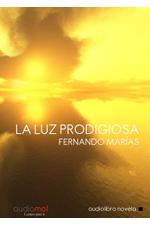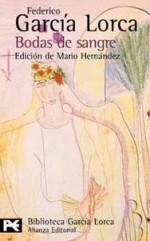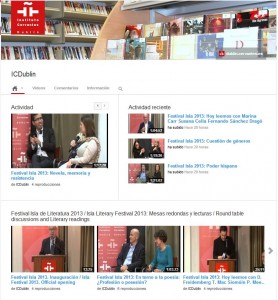Blog del Instituto Cervantes de Dublín
Torre Martello
Audiobook of the week / Audiolibro de la semana: La luz prodigiosa
 ¿Murió Federico García Lorca realmente en 1936? Esa es la pregunta que se hace el escritor Fernando Marías en su novela La luz prodigiosa, nuestro audiolibro de la semana.
¿Murió Federico García Lorca realmente en 1936? Esa es la pregunta que se hace el escritor Fernando Marías en su novela La luz prodigiosa, nuestro audiolibro de la semana.
Lo cierto es que jamás se encontraron sus restos, que sólo conocemos lo sucedido de forma fragmentaria y que aún faltan muchas piezas que juntar en el siniestro rompecabezas de su desaparición.
En La luz prodigiosa, la respuesta a esta pregunta va surgiendo, poco a poco, en boca de un viejo vagabundo y borracho, el mismo que hace cincuenta años encontró por casualidad a un joven moribundo tirado al borde de un camino y, sin conocer su identidad, le salvó la vida. ¿Qué fue a partir de entonces de aquel joven? ¿De qué manera sobrevivió a la guerra? ¿Por qué estos hechos quedaron olvidados hasta hoy?
La novela de Fernando Marías fue adaptada al cine en 2003 con notable éxito. Ahora, para escucharla, solo necesitas tu carné de biblioteca y tu contraseña.
Did Federico García Lorca die in 1936? That’s the question that Spanish writer Fernando Marías puts to us in his novel La luz prodigiosa, our audiobook of the week.
The truth is that his remains were never found. We only know what happened in a piecemeal and there are still many pieces missing in the puzzle of his sinister disappearance.
In La luz prodigiosa, the answer to this question emerges slowly from an old man, tramp and drunk. The same man that fifty years ago saved the live of a dying young man he discovered on the edge of a road, not even knowing his identity. What happened thereafter to that young man? How he survived the war? Why these facts were forgotten until today?
Fernando Marías‘s novel was adapted into a film in 2003 with remarkable success. Now, to listen to the audiobook version, you just need your library card and your password.
[Video] Cecilia Gandarias habla sobre la exposición «Geografía Postal»
En la primera mitad del siglo XX, las familias García Lorca y De los Ríos se enviaban postales casi todos los días, creando así una amplísima colección que ahora se expone en el Instituto Cervantes. Cecilia Gandarias, comisaria de la exposición, nos habla de cómo surgió la idea para esta exposición y de como se realizó la selección de las postales.
La exposición estará abierta del 20/09/2012 al 17/11/2012.
El horario de visita es: Lun.- jue.: 14-19 h. Sáb: 10-14 h. Cerrado vie., dom. y festivos
In the first half of the 20th Century two families, García Lorca and De los Ríos, sent each other postcards almost daily. A selection of this huge collection of postcards is now on display at the Instituto Cervantes in Dublin. Cecilia Gandarias, exhibition curator, explains us in this video how they came to the idea of organizing this exhibition and how Martin Parr, photographer and specialist in postcards, made the selection.
This display will bring us closer to the most intimate side of the poet´s life.
The exhibition is open fro the 20/09/2012 to 17/11/2012.
Opening hours: Mon-Thur: 2-7pm. Sat: 10am-2pm. Closed on Fridays, Saturdays and Bank Holidays.
Federico García Lorca: nuestro autor del mes de septiembre
 Desde el día 20 de este mes y hasta el 17 de noviembre contaremos en el Instituto con la exposición “Geografía postal. Las postales de las familias García Lorca y De los Ríos”.
Desde el día 20 de este mes y hasta el 17 de noviembre contaremos en el Instituto con la exposición “Geografía postal. Las postales de las familias García Lorca y De los Ríos”.
En la biblioteca, aprovechamos esta ocasión para recordar al que en la actualidad es el poeta español más leído de todos los tiempos. Fundamental es también su figura en el teatro español contemporáneo. En 1915 comienza a estudiar Filosofía y Letras y Derecho en la Universidad de Granada. Formó parte de El Rinconcillo, centro de reunión de los artistas granadinos donde conoce a Manuel de Falla quien ejerció una gran influencia en él, transmitiéndole su amor por el folclore y lo popular.
A partir de 1919, se instaló en Madrid, en la Residencia de Estudiantes, donde conoció a Juan Ramón Jiménez y a Machado, y trabó amistad con poetas de su generación y artistas como Buñuel o Dalí. En este ambiente, Lorca se dedicó con pasión no sólo a la poesía, sino también a la música y el dibujo, y empezó a interesarse por el teatro.
From the 20th of this month until the 17th of November, you can enjoy at the Institute the exhibition “Postal Geography. García Lorca and De los Ríos Families´s Postcards”.
At the library, we take the chance to remember the most read Spanish poet of all times. He is also an essential part of contemporary Spanish theatre. He started to study Philosophy and Literature and also took Law studies at the University of Granada. He was part of El Rinconcillo, a meeting point for the artists of Granada where he met Manuel de Falla who was a big influence, learning from him about folk and tradition .
In 1919 he moved to Madrid and lived in the Residence for Students, where he met Juan Ramón Jiménez and Machado and he became good friend of poets and artists of his generation such as Buñuel or Dalí. Lorca worked with passion in that environment in poems and also in music, drawing and he started to be interested in theatre.





